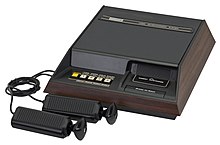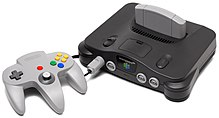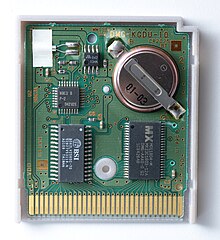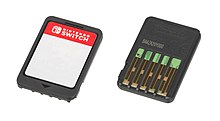ROM cartridge
This article needs additional citations for verification. (October 2011) |

A game cartridge, usually referred to in context simply as a cartridge, cart, or card, is a replaceable part designed to be connected to a consumer electronics device such as a home computer, video game console or, to a lesser extent, electronic musical instruments.[1] A special type of cartridge named ROM cartridge is a memory card containing ROM. ROM cartridges can be used to load and run software such as video games or other application programs.
The cartridge slot could also be used for hardware additions, RAM expansions or speech synthesis for example. Some cartridges had battery-backed static random-access memory, allowing a user to save data such as game progress or scores between uses.
ROM cartridges allowed the user to rapidly load and access programs and data without using a floppy drive, which was an expensive peripheral during the home computer era, and without using slow, sequential, and often unreliable Compact Cassette tape. An advantage for the manufacturer was the relative security of the software in cartridge form, which was difficult for end users to replicate. However, cartridges were expensive to manufacture compared to floppy disks or CD-ROMs. As disk drives became more common and software expanded beyond the practical limits of ROM size, cartridge slots disappeared from later game consoles and personal computers. Cartridges are still used today with handheld game consoles such as the Nintendo DS, Nintendo 3DS, PlayStation Vita, and the tablet-like hybrid console Nintendo Switch, although sometimes referred to as game cards.
Its widespread usage for video gaming has led the ROM cartridge to be often colloquially called a game cartridge.
History[]

ROM cartridges were popularized by early home computers which featured a special bus port for the insertion of cartridges containing software in ROM. In most cases the designs were fairly crude, with the entire address and data buses exposed by the port and attached via an edge connector; the cartridge was memory mapped directly into the system's address space[2] such that the CPU could execute the program in place without having to first copy it into expensive RAM.
The Texas Instruments TI 59 family of programmable scientific calculators used interchangeable ROM cartridges that could be installed in a slot at the back of the calculator. The calculator came with a module that provides several standard mathematical functions including solution of simultaneous equations. Other modules were specialized for financial calculations, or other subject areas, and even a "games" module. Modules were not user-programmable. The Hewlett-Packard HP-41C had expansion slots which could hold ROM memory as well as I/O expansion ports.

Notable computers using cartridges in addition to magnetic media were the Commodore VIC-20 and 64, MSX standard, the Atari 8-bit family (400/800/XL/XE),[3] the Texas Instruments TI-99/4A (where they were called Solid State Command Modules and were not directly mapped to the system bus) and the IBM PCjr[4] (where the cartridge was mapped into BIOS space). Some arcade system boards, such as Capcom's CP System and SNK's Neo Geo, also used ROM cartridges.

A precursor to modern game cartridges of second generation video consoles was introduced with the first generation video game console Magnavox Odyssey, using jumper cards to turn on and off certain electronics inside the console. A modern take on game cartridges was invented by Wallace Kirschner and Lawrence Haskel of Alpex Computer Corporation, first unveiled as part of the Fairchild Channel F home console in 1976.[5][6] The cartridge approach gained more popularity with the Atari 2600 released the following year. From the late 1970s to mid-1990s, the majority of home video game systems were cartridge-based.[6] As compact disc technology came to be used widely for data storage, most hardware companies moved from cartridges to CD-based game systems. Nintendo remained the lone hold-out, using cartridges for their Nintendo 64 system; the company did not transition to optical media until 2001's GameCube. SNK still released games on the cartridge-based Neo Geo until 2004, with the final official release being Samurai Shodown V Special. Nintendo's handheld consoles, meanwhile, continued to use cartridges due to their faster loading times and minimal equipment for data reading being beneficial for playing video games in short, several-minute intervals.
Design[]

ROM cartridges can not only carry software, but additional hardware expansions as well. Examples include the Super FX coprocessor chip in some Super NES game paks, the SVP chip in the Sega Genesis version of Virtua Racing, and voice and chess modules in the Magnavox Odyssey².
Micro Machines 2 on the Genesis/Mega Drive used a custom "J-Cart" cartridge design by Codemasters which incorporated two additional gamepad ports. This allowed players to have up to four gamepads connected to the console without the need for an additional multi-controller adapter.
The ROM cartridge slot principle continues in various mobile devices, thanks to the development of high density low-cost flash memory. For example, a GPS navigation device might allow user updates of maps by inserting a flash memory chip into an expansion slot. An E-book reader can store the text of several thousand books on a flash chip. Personal computers may allow the user to boot and install an operating system off a USB flash drive instead of CD ROM or floppy disks. Digital cameras with flash drive slots allow users to rapidly exchange cards when full, and allow rapid transfer of pictures to a computer or printer.
Advantages and disadvantages[]

Storing software on ROM cartridges has a number of advantages over other methods of storage like floppy disks and optical media. As the ROM cartridge is memory mapped into the system's normal address space, software stored in the ROM can be read like normal memory; since the system does not have to transfer data from slower media, it allows for nearly instant load time and code execution. Software run directly from ROM typically uses less RAM, leaving memory free for other processes. While the standard size of optical media dictates a minimum size for devices which can read disks, ROM cartridges can be manufactured in different sizes, allowing for smaller devices like handheld game systems. ROM cartridges can be damaged, but they are generally more robust and resistant to damage than optical media; accumulation of dirt and dust on the cartridge contacts can cause problems, but cleaning the contacts with an isopropyl alcohol solution typically resolves the problems without risk of corrosion.[7]
ROM cartridges typically have less capacity than other media.[8] The PCjr-compatible version of Lotus 1-2-3 comes on two cartridges and a floppy disk.[9] ROM cartridges are typically more expensive to manufacture than discs, and storage space available on a cartridge is less than that of an optical disc like a DVD-ROM or CD-ROM. Techniques such as bank switching were employed to be able to use cartridges with a capacity higher than the amount of memory directly addressable by the processor. As video games became more complex (and the size of their code grew), software manufacturers began sacrificing the quick load time of ROM cartridges for the greater capacity and lower cost of optical media.[10][11] Another source of pressure in this direction was that optical media could be manufactured in much smaller batches than cartridges; releasing a cartridge video game inevitably came with the risk of producing thousands of unsold cartridges.[12]

Electronic musical instruments usage[]
Besides their prominent usage on video game consoles, ROM cartridges have also been used on a small number of electronic musical instruments, particularly electronic keyboards.
Yamaha has made several models with such features, with their DX synthesizer in the 1980s, such as the DX1, DX5 and DX7 and their PSR keyboard lineup in the mid-1990s, namely the PSR-320, PSR-420, PSR-520, PSR-620, PSR-330, PSR-530 and the PSR-6000. These keyboards use specialized cards known as Music Cartridges, a ROM cartridge simply containing MIDI data to be played on the keyboard as MIDI sequence or song data. This technology, however, quickly become obsolete and extremely rare after the advent of floppy disk drive in later models.[citation needed]
Casio has also known to use similar cartridges known as ROM Pack in the 1980s, before Yamaha's Music Cartridge were introduced. Few examples are several models in Casiotone line of portable electronic keyboards.[13]
Cartridge-based video game consoles[]

Fairchild Camera and Instrument
- Pixter
- Smart Cycle
LeapFrog
- Magnavox Odyssey
- Magnavox Odyssey 2/Philips Videopac G7000
Nikko Europe
- digiBLAST
- NES/Famicom (with its clones like )
- SNES/Super Famicom
- Nintendo 64
- Game Boy
- Game Boy Color
- Game Boy Advance
- Virtual Boy
- Pokémon Mini
- Nintendo DS
- Nintendo 2DS
- Nintendo 3DS
- Nintendo Switch
- SG-1000 Mark I/SG-1000 Mark II
- Sega Master System/Sega Mark III
- Sega Genesis/Mega Drive
- Sega Game Gear
- Sega Pico
- Sega 32X
- Genesis Nomad
- Advanced Pico Beena
SNK
See also[]
References[]
- ^ https://dictionary.cambridge.org/dictionary/english/cartridge
- ^ US patent 4485457A, Richard K. Balaska, Robert L. Hunter, and Scott S. Robinson, "Memory system including RAM and page switchable ROM", issued 1984-11-27, assigned to CBS Inc.
- ^ Pollson, Ken (October 30, 2008). "Chronology of the Commodore 64 Computer". Archived from the original on January 18, 2010. Retrieved February 26, 2009.
- ^ Hoffmann, Thomas V. (March 1984). "IBM PCjr". Creative Computing. 10 (3): 74.
- ^ Edwards, Benj (January 22, 2015). "The Untold Story Of The Invention Of The Game Cartridge". Fast Company. Retrieved April 6, 2021.
- ^ Jump up to: a b "1976: Fairchild Channel F – First ROM Cartridge Video Game System". CED Magic. Retrieved February 26, 2009.
- ^ NES Cleaning Kit manual
- ^ Cook, Karen (March 6, 1984). "Jr. Sneaks PC into Home". PC Magazine. p. 35. Retrieved October 24, 2013.
- ^ Trivette, Donald B. (April 1985). "Lotus 1-2-3 For IBM PCjr". Compute!. p. 63. Retrieved January 26, 2015.
- ^ "The SNES CD-ROM". Gamer's Graveyard. Archived from the original on July 4, 2008. Retrieved February 26, 2009.
- ^ Isbister, Katherine (2006). "Interview: Ryoichi Hasegawa and Roppyaku Tsurumi of SCEJ". Better Game Characters by Design: A Psychological Approach. San Francisco, California: Elsevier Inc. p. 99. ISBN 978-1-55860-921-1. Retrieved February 26, 2009.
- ^ "Who You Pay to Play". Electronic Gaming Monthly. Ziff Davis (82): 16–18. May 1996.
- ^ "Casio ROM Packs". www.crumblenet.co.uk.
External links[]
- History of Home Video Games at the Wayback Machine (archived April 8, 2005)
- Solid-state computer storage media
- Computer connectors
- Video game distribution